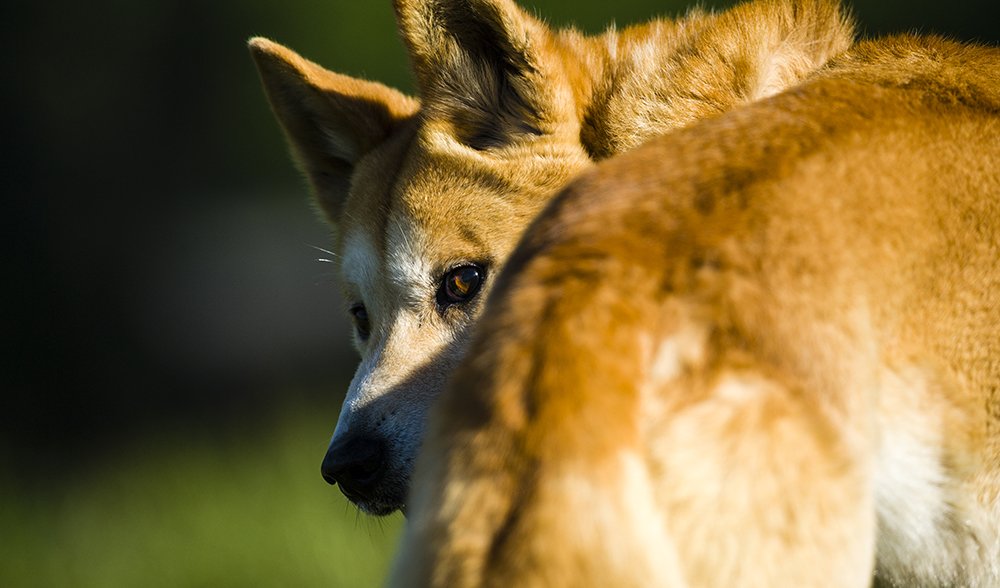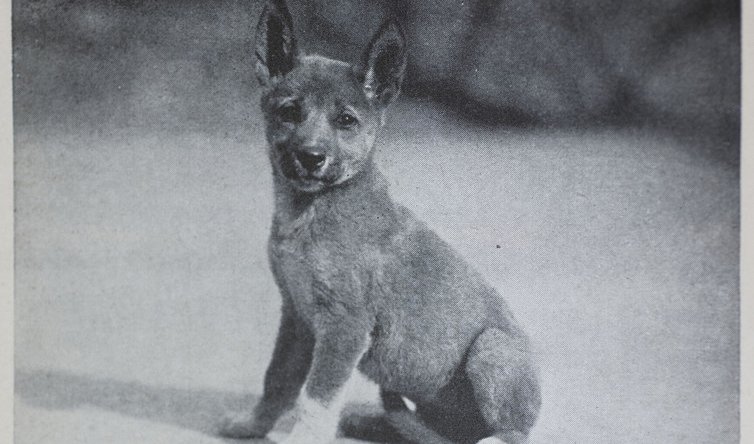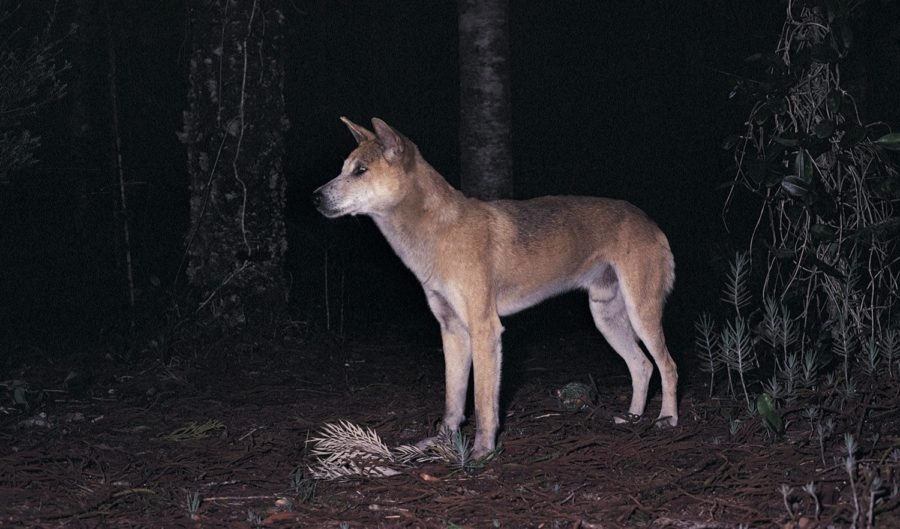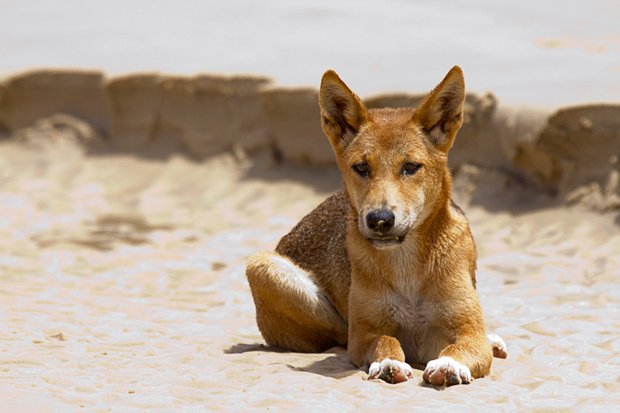The corrugated-iron shearing shed is all that’s left of the days when sheep grazed the stony plains of Mt Willoughby station, north of Coober Pedy, in South Australia.
The last sheep were shorn here more than 30 years ago, and cattle are now king on the edge of the Great Victoria Desert. But 84-year-old Bill Lennon’s memory is long. He spent his childhood roaming this country, shepherding with his maternal grandparents, mother and siblings.
“We lit little fires at night to keep the dingoes away,” says the Antikarinya Aboriginal elder. “But those old dingoes didn’t bother us. We live together; my grandmother and grandfather each had a dingo. In the night-time, if there was danger around, they would warn us and protect us. They are one of our totems. When an Aboriginal man goes through the law he might become a perentie man, an emu man, a kangaroo man or a dog man. Those dingoes watch over the dog men and make them spiritually strong. They do their job – they are part of our Dreaming.”
It’s a very different story outside the East Gippsland town of Omeo, in north-eastern Victoria. Beside the road to Benambra, a prominent gum tree drips with about 30 dog carcasses in various states of decay. Sun-bleached skeletons, matted pelts, bared teeth – slowly spinning in the breeze. Many, such as one of the newest trophies, closely resemble the archetypal dingo – lean, golden animals with broad heads. Others are brindle, black, and spotted – more like domestic pets.

To the sheep and cattle producers around here there is no distinction. Any dog that poses a threat to stock is shot on sight. Most farmers bait extensively in autumn and spring with the poison 1080, yet still they suffer stock losses. “In this undulating country, a dog could be attacking sheep in the next valley and you’d never know,” says one grazier. A single, persistent dog, or, worse, a roving pack, can cost a family their livelihood and sanity.
Before installing electric fencing and carrying out concerted baiting, Penny and Fraser Barry, of Bindi station, just south of Omeo, were losing 1500 sheep a year and lambing in some mobs was down to just 10 per cent. The farm that Penny’s ancestors established in 1850 was besieged. “We went through 15 years of losses; we were fighting for survival,” says Fraser. “I was spending 100 per cent of my time on dogs, up all night trying to shoot them. I couldn’t sleep; I was physically and emotionally exhausted. It’s been described as a form of post-traumatic stress. We felt useless.”
On the fence
Few animals divide opinions quite like the dingo. Loved as a mysterious outback icon, or loathed as a marauding killer – it depends on which side of the fence you sit. In all but its most far-flung territories, the dingo is now near indistinguishable from feral dogs or hybrids of the two. In fact, cross-breeding probably poses the greatest threat to the purebred dingo. In land-management terms, however, the prevailing thinking is that the dingo is a wild dog and that some wild dogs are dingoes.
Legislation deems the dingo (Canis lupus dingo – thought to be descended from domesticated dogs in Asia) a pest on private land in every mainland state and territory except the NT. Across the 60 per cent of SA outside the dog fence, dingoes are not even protected in national parks, but baiting is restricted to ensure its survival as a ‘wildlife species’. In Victoria, the dingo is listed as a threatened species and protected in national parks under the Wildlife Act 1975, but is fair game on private land or within a 3km buffer of public land boundaries to safeguard livestock. The same rule applies in NSW, Queensland, SA and WA, where land managers are legally required to cull them.
“Not all dogs will, but any dog has the potential to kill livestock,” says Greg Mifsud from the Invasive Animals Cooperative Research Centre. The National Wild Dog Action Plan (NWDAP), introduced in 2015 with the backing of industry and government, advocates a landscape approach to controlling “wild-living dogs, including dingoes, feral dogs and their hybrids”. It supports aerial and ground baiting, trapping, fencing, the use of guardian dogs and shooting, where necessary.

“The annual cost to the Australian economy in sheep and cattle losses from wild dogs and control efforts is in the hundreds of millions of dollars,” says Greg, whose role and program is funded by Australian Wool Innovation.
“It’s an emotionally charged issue, with strong economic impacts. It’s about individual landholders assessing the risk that dogs pose to them, and being cognisant of the risks to their neighbours. We are not about obliterating dingoes; we recognise their place in national parks. We want to provide long-term opportunities for production and dingo conservation.”
Second-generation dingo scientist Dr Ben Allen has spent years investigating practical solutions to this complex problem. Although he contributed to the NWDAP, he says it has a relatively minor focus on the benefits of dingoes and he’s intent on developing a complementary national dingo conservation plan.
An ecologist with the University of Southern Queensland in Toowoomba, he says there is little evidence to prove the widely touted theory that dingoes could help halt Australia’s biodiversity collapse by suppressing feral cats and foxes. However, there is good data to indicate that dingoes control kangaroo numbers, thereby benefiting cattle producers.
“I wouldn’t be baiting routinely in arid and semi-arid cattle production areas; it often has no benefit and can sometimes make matters worse,” Ben says. “But nor would I inhibit landholders from controlling dogs if they needed to, such as during dry times. Depending on the place, they present opportunities or problems, and need to be managed accordingly. Dingoes can be benign one minute and your worst enemy the next.”
Wild dogs are, unequivocally, public enemy number one for sheep producers. “Sheep and dogs will never get along and sheep graziers will need to fence, bait and have guardian dogs,” Ben says. “The greatest conflict comes when you have someone who baits next door to someone who doesn’t. Dingoes have evolved to exploit whatever humans do.”
Cunning canines
The dingo is nothing if not adaptable. Dr Guy Ballard, an ecologist with the NSW government’s Vertebrate Pest Research Unit and the University of New England, has studied them for a decade. “They are incredibly successful animals, which can live at high-altitude on high, bony ridges, in rainforests and in the harshest deserts,” he says.
“We have tracked dogs in the desert in 50°C heat, walking 10km to get drips from a tap, and, on the coast, watched a mother swimming her pups across a canal. They roam towns, and live around airports, caravan parks and rubbish tips. The same species does totally different things in different environments. They do whatever they need to survive.”
Guy says he is astounded by the distances dingoes cover. “They can travel well over 100km and back in a week. This ability to colonise and recolonise is important. If we are trying to remove dogs from an environment, it might be at a scale of one-tenth of their ecological capacity. Similarly, conserving dingoes in small areas might be a waste of time. The size of territories may even be site specific. Modern dingoes are very much a product of the Australian landscape.”
As Jim Benton well knows, his quarry is opportunistic, resourceful and highly intelligent. As one of 18 wild dog controllers employed by Victoria’s Department of Environment, Land, Water and Planning (DELWP), he spends his days setting and checking traps throughout East Gippsland. He and his kelpie, Reckless, are often first on the scene after a dog has attacked stock.
“Sometimes I have caught the dog in a week, but a cunning dog can take months,” he says. “The longer they go, the smarter they get. I spend a lot of time trying to work out where they’re travelling. Dogs have been radio-tracked travelling 400km from here to Tumut and back, and I’ve seen 30 sheep killed in one night. If we cut back on our work, numbers explode.”

Still, Jim accords dingoes respect. “They are only dogs, doing what’s natural,” he says. “And only the strongest survive. If they weren’t territorial, they would be impossible to catch. But even a cunning dog will come unstuck and they do die of old age eventually.”
Victoria has one of the country’s most active baiting programs, says state manager of the DELWP’s wild dog program Barry Davies, and it’s been very successful in reducing stock losses. “We’re not trying to remove all dogs, but we are determined to minimise their impact,” he says. Like elsewhere in the country, property owners are also increasingly using cluster fencing, electric fencing and guardian animals – including dogs, alpacas and donkeys – to protect their flocks.
After losing 1000 lambs over 13 years on his farm in the Omeo Valley, Bob Lee had great success with his five Maremmas before they were mistaken for wild dogs and shot by deer hunters. “I had no sheep killed in four years, but within a week of me losing my last Maremma, dogs came in and mauled half a flock of 100 sheep,” Bob says.
The losses convinced him to sell part of his farm and switch to cattle. “A lot of people in the district have gone out of sheep,” he says. “Omeo had five shearers and now we have one, and that’s not counting the rouseabouts and wool classers we’ve lost. I reckon the dogs have knocked 25 or 30 families out of our community.”
“War on dogs”
Angus Emmott’s views about dingoes have not endeared him to all his neighbours around Longreach, Queensland. “Some, like me, are not baiting or shooting dingoes but wouldn’t be game to admit it,” says the cattleman, naturalist and keen photographer.
I’ve received hate mail on social media, but I have been working on this theory for 15 years and I’m certain we need to change the way we manage our ecosystems. We have this mindset that we have to kill dingoes, because that is what we have always done.”
On 50,000ha Noonbah station, Angus refused to join the ‘war on dogs’. In his experience, when he leaves dingoes alone, they form settled packs that permit only senior females to breed and keep young dogs under control. “The dingoes rarely touch the calves, keep the roo numbers down and also take out feral cats, foxes and goats,” he says. “It’s in the interests of cattle production and has great biodiversity benefits. We have a horrific history of mammal extinctions in Australia and have lost the least mammals from places where dingoes have been left,” he adds (see AG#100).

South Australian landholders Caroline Thomas and John Knight, whose property adjoins Mt Willoughby, are keeping a similarly open mind. They are opposed to baiting dingoes, both philosophically and in order to meet their organic beef certification requirements. “We are letting nature take its course,” Caroline says.
“There will be some losses in dry years but we will try to manage stocking rates to ensure the cattle are strong enough to defend their calves from dingoes. Ours is what you would call predator-friendly production, but every property is different, with different country, watering points and grazing pressures.”
John says that they have never killed a dingo on 2347sq.km Evelyn Downs and would only rethink that policy if dogs became a significant problem. “We believe that dingoes are important to maintaining long-term ecological stability,” he says. “On evidence, it is better for us to suffer cattle losses (about 30 a year in drought) than kill dingoes indiscriminately and cause chaos in the dog population. However, we are vigilant and watching all the time to see if this is the best approach.”
Dr Arian Wallach, an ecologist with the Centre for Compassionate Conservation at the University of Technology in Sydney, is in no doubt. After five years exploring the relationships between dingoes and other wildlife on Evelyn Downs and Mt Willoughby, she says she firmly believes that killing causes an increase in dingo densities and predation, because their hierarchy is disrupted.
“When pressures on dingoes stabilise, so does their population,” Arian says. She agrees that natural dingo function can improve native pasture and cattle growth, and, ultimately, a producer’s bottom line. Arian presents a strong argument for ceasing 1080 baiting and the broader “persecution” of dingoes. “It has become oddly easy to kill dingoes by calling them wild dogs,” she says. “If you take away the notion that they are native, then they lose their conservation value and you can do whatever you want to them.
“If we can’t even protect dingoes from baiting in national parks, where they commonly die from baits said to have been laid for foxes, it’s a bit much to ask sheep farmers to protect them. But I am encouraged to see small pockets of predator-friendly production in Australia, where the focus is shifting from controlling dingoes to protecting livestock.”
First-time property owners Jake Fennell and Frankie Lumb say that refraining from baiting is simply not an option on 3812sq.km Wintinnna. None of their immediate neighbours bait, due to organic beef production or spiritual beliefs (they border the Anangu Pitjantjatjara Yankunytjatjara (APY) Lands, Evelyn Downs and Mt Willoughby). With Tallaringa Conservation Park to the west, they say they are exposed to hundreds of dingoes.
“A lot of dogs are coming out of the APY Lands and the conservation park,” says Jake. “During drought, you see more. When the dogs are thick, we could lose 25 per cent of our calves, but we bait all the time with factory baits and get a delivery of injected baits yearly to blanket the property. We would like more to create a chemical barrier around our place.
“We have seen dingoes chewing on the back legs of calves, their tails and lips, and then had to put them down. When you have a few dogs hunting together, no cow is good enough to protect her calf. A lot of the studies have been done by people who like dingoes, who don’t look at what it takes to make the most out of a pastoral lease.”
Charismatic canines
It used to be that you had to travel to Fraser Island or into Central Australia to see a dingo. They remain elusive, that’s true, but cross-breeding, control measures and habitat fragmentation is bringing the dingo into closer contact and conflict with people. It saddens Lyn Watson, who has devoted 30 years to dingo conservation at the Australian Dingo Discovery and Research Centre on the outskirts of Melbourne.
“We don’t recommend them as pets, but the wave of anti-dingo sentiment sweeping Australia makes me think that people are going to have to keep them as pets if the species is to survive,” Lyn says. “These are magic animals – and they are Australian and we are killing them. They are our top predator, the equivalent of Australia’s lion, and they are responsible for keeping our biodiversity intact. Dingoes are our only chance against feral cats and foxes. Once the dingo is gone, poisons are all that we will have left.”
At the centre she established with her late husband, Peter, Lyn and her team of volunteers care for 40 purebred dingoes and their litters, and conduct community education. She wants to see dingoes taken off the pest list and protected nationally. “But here in Victoria they are reinstating the bounty on dingoes,” Lyn says. “This beautiful animal – engineered to perfection – is efficient and made for survival on the Australian continent.”
Guy Ballard agrees there is something charismatic about the species he’s spent years tracking along the ranges and coasts of northern NSW. “They are a very engaging animal and culturally many Australians feel an ownership of dingoes, but nobody owns dingoes,” he says. “We still have much to learn and any conservation efforts need to take into account their wildness.”
Despite 200 years of dingo control, many scientists believe that there are more dingoes now than ever. They are free to roam large parts of the continent unhindered and in many cases the provision of rabbits, livestock and watering points (that attract macropods) has enabled this opportunistic species to expand its range. “Dingoes are still here and numbers are still increasing, even though we have eradicated them from about 15 per cent of the continent,” says Ben Allen.
Because they killed a few sheep – sheep that were brought onto the dingo’s land – they were locked out of their country. Like us.
Antikarinya elder Bill Lennon was 13 when he was taken away from his family and his country, to a mission in Port Augusta. He spent 56 years working his way back home. Now, as owners of the Indigenous Protected Area that takes in the cattle station at Mt Willoughby, the Lennon family is determined to run a profitable enterprise in concert with nature. That means not baiting dingoes and tolerating stock losses.
“When I was a kid there were dingoes everywhere,” he says. “You would hear them late at night, howling, answering one another. It was like music. Lovely. But because they killed a few sheep – sheep that were brought onto the dingo’s land – they were locked out of their country. Like us. But we are the people and these are the animals that have been treading this land for thousands of years.”
This article was originally published in the Jan-Feb 2017 issue of Australian Geographic (AG#136)




